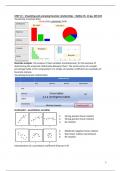Summary
Summary test 2 Research Methodology and Descriptive Statistics - Premaster Business Administration - University of Twente
- Course
- Institution
- Book
In this summary you can find the micro lectures of this course. It is supplemented with parts from the book of Earl Babbie. This summary is about unit 12-22 & 24.
[Show more]




